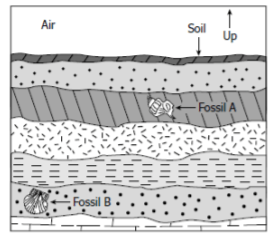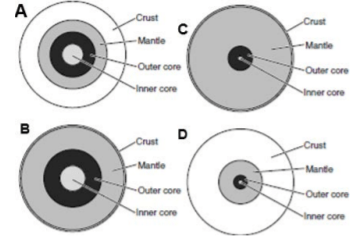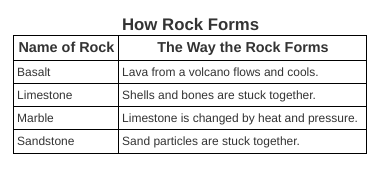The largest Layer of the Earth
Mantle
How are igneous rocks formed?
melting and cooling
Plates that move apart cause ________ boundaries
Divergent
Why are fossils important?
Fossils provide scientists with information and evidence about the past
The process that breaks down rocks and other materials into sediments
Weathering
The layer we live on (the thinnest layer)
Crust
How are sedimentary rocks formed?
weathering/erosion of sediments. Cementing and compacting of those sediments.
Plates that move together cause ________ boundaries
Convergent
Which fossil is older (A or B)?
Fossil B is older
Which process is taking place when water freezes between cracks in rocks?
Weathering
The layer that is compressed solid metal (like a marble)
Inner Core
How are metamorphic rocks formed?
Heat and Pressure
Plates that slip past each other cause ________ boundaries
Transform
Which BEST explains why fossils of sea animals can be found on land?
A. Sea animals learned to live on dry land.
B. The land and fossils were once under water.
C. There was more rainfall when the animals were alive.
D. Sea animals were carried onto land by animals that ate them.
B.
The movement of sediments, minerals, rocks, and soil is known as
Erosion
Layer made of mostly liquid iron and nickle
Outer Core
What types of rocks would be found near volcanoes?
Igneous
Which boundaries cause earthquakes?
ALL (divergent, convergent, and transform)
What type of rock are fossils mostly found in
Sedimentary
Planting trees and bushes best prevents which process?
Erosion
Which diagram accurately represents the layers of the Earth

B.
Which rock would be igneous?

Basalt
Which boundaries cause volcanoes?
Convergent and Divergent
Name at least one example of a sedimentary rock
Limestone, shale, sandstone, coal
The addition of sediments, soil and rocks to land or landforms is known as
Deposition
Name 2 layers that are made of rocky materials?
AND
Name 2 layers that are made of mostly iron and nickel?
Crust and Mantle are rocky
Outer Core and Inner Core are mostly iron and nickel
A student made observations of four rock samples. Which of these observations most likely describes a sedimentary rock?
a. Sample 1 has bands of light and dark crystals.
b. Sample 2 has pink, gray, and white crystals grown together.
c. Sample 3 is made up of one huge, pale pink crystal.
d. Sample 4 is made up of layers of sand grains cemented together.
d.
The term for when a plate slides under another plate due to convergent boundaries
Subduction
The same fossils found on different continents supports the idea that all of the continents were once connected. This supercontinent was called ________
Pangaea
Name 2 natural causes of weathering, erosion, and deposition
Wind, Ice, Water